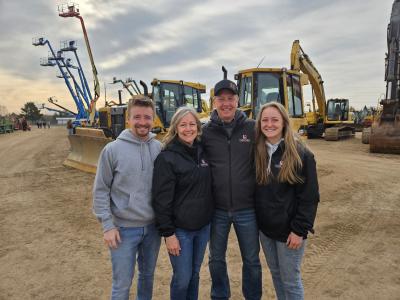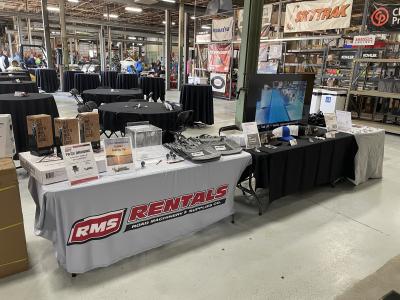The San Francisco-Oakland Bay Bridge is currently in the middle of a major overhaul. The bridge connects San Francisco with the East Bay, and was originally opened on Nov. 12, 1936. It covers 8.4 mi. (13.5 km), and is actually two separate bridges, a tunnel, and a mile-long elevated roadway.
When a 250-ton (227 t) section of the East Span’s upper deck collapsed in 1989 because of a 7.1-magnitude earthquake, officials took a serious look at the bridge.
Although the span was reopened after a month of repairs, the California Department of Transportation determined that a new bridge should be built, one that would survive heavy seismic activity and also provide access for emergency services and rebuilding efforts following a major earthquake.
The Department worked with the Metropolitan Transportation Commission to develop a design, which was then divided into six major projects to help accommodate the 280,000 vehicles that cross the bridge each day.
The Seismic Retrofit, as the project is called, is currently on schedule, and to date has reportedly created 126,000 jobs. The estimated cost for the new Bay Bridge (the East Span) is $5.487 billion, with project costs reportedly evaluated quarterly.
Information on the various projects is as follows:
Self-Anchored Suspension Span
Construction of the Self-Anchored Suspension Span project began in 2006, and is set for completion in 2013. The prime contractor is American Bridge/Fluor (A Joint Venture).
The entire span is 2,047 ft. (624 m) in length and contains 50,000 tons (45,359 t)of steel. It will be the world’s largest SAS bridge.
While traditional main cable suspension bridges have twin cables, this particular bridge will have only one, which is anchored within the eastern end of the roadway. It is carried over a single tower and wraps around the two side-by-side decks at the western end. The single steel tower will be made up of four separate legs connected by shear link beams. The beams are designed to absorb most of the impact from an earthquake.
Bart Ney, senior communications manager for the Caltrans Toll Bridge Program, noted that American Bridge/Fluor Enterprises Inc., A Joint Venture (ABFJV) faced two big challenges from an equipment standpoint on this project. They involved the erection of the Orthotropic Box Girder (OBG) Lifts and the Permanent Tower.
“The challenge created by each of the 28 ’lifts’ of OBG’s was their massive weight, which ranges from 520 metric tons for the lightest piece all the way up to 1,581 metric tons for the heaviest piece,” he explained.
To meet this challenge, ABFJV had a barge mounted Shear Leg Crane designed and fabricated having a maximum lift capacity of 1,929 tons (1,750 t). The “Left Coast Lifter” (LCL) is comprised of a 400 by 100 by 22 ft. (122 by 30.5 by 6.7 m) deck barge affixed with a shear leg crane whose boom length is 328 ft. (100 m) and the boom alone weighs 992 short tons (886 long tons). The LCL not only had to erect these large OBG Lifts, but it also was required to offload them onto awaiting barges from the Vessel which transported the fabricated sections from China.
“As the LCL is a non-powered Vessel, it relies on an anchor wire and spud system to maneuver it into place for each lift. The LCL’s horizontal translation across the Baby during each OBG lift is guided by a GPS system which uses points both on the Boom as well as the Machinery House to position it to within +-4mm of its intended target location. This precision is required because the OBG Lifts have to be lowered to an exact location onto its awaiting ’cradle’ carried by the temporary falsework system that supports the OBG’s until the Main Suspension Cable is erected.”
Ney noted that the permanent tower consists of four independent shafts, each made up of four field spliced segments referred to as “Lifts 1 through 4” and connected by Shear Link Beams and Crossbraces. The weight of Lifts 1 through 4 ranges between 1,213 (1,100 t) and 497 tons (1,100 and 450 t)? and length ranges between 157 and 108 ft. (48 and 33 m). The four shafts are capped by a single built up fabricated piece referred to as the “Tower Grillage” (Lift 5), and finally, the tower’s supporting element for the roadway cable, the “Tower Saddle” (Lift 6). The Tower Grillage and the Tower Saddle will each weight approximately 497 tons. The completed T1 Tower will stand 518 ft. (158 m) above water level.
“In order to construct the permanent tower, ABFJV designed and fabricated a temporary Erection Tower,” Ney said. “The Erection Tower is a temporary tower that encompasses the perimeter of the permanent tower, sharing the same permanent foundation, and stands 528.2 ft. (161 m) tall. Attached to the Erection Tower is a hoisting system that is used to lift and translate permanent Tower Lifts 1 through 6 into their final position. This system provides translation in both the East-West direction and the North-South direction via two separate sets of ’gripper jacks’ connected to Hilman rollers. The gripper jacks grip the top flange of their respective Erection Tower beam using a fulcram-jack mechanism and a separate push-pull jack connected to the Hilman rollers to push and pull the system East and West or North and South.”
The Hilman rollers range from 441 to 882 tons (400 to 800 t) capacity. Two 727.5 ton (660 t) Enerpac strand jacks are used to life the Permanent Tower sections. For the larger loads, the strand jacks utilize 55 ea.-0.6 in. (1.5 cm) prestressing strands at their maximum capacity, have maximum stroke of 16 in. (40.6 cm), and a cycle time of 96 seconds per stroke.
Oakland Touchdown
The Oakland Touchdown portion of the bridge project began in 2007, and Phase 1 was completed in 2010. The prime contractor was MCM Construction. Phase 2, which has not yet been awarded, will be completed in 2013.
The Touchdown portion is 4,229 ft. (1,289 m) in length and contains 9,400 tons (8,527.5 t) of steel and 92,176.5 cu. yds. (70,474 cu m) of concrete.
Located just west of the Bay Bridge toll plaza, this section will connect Interstate 80 in Oakland and the new side-by-side decks of the new East Span. The project involves two roadway sections and a new electrical substation, in addition to extensive relocation of underground utilities.
The Web site noted that before any work on this portion could begin, crews had to relocate and replace the underwater electrical cables that provided power to Yerba Buena Island and Treasure Island, since they were too close to foundation work.
Yerba Buena Island
Transition Structure
The project to complete the Yerba Buena Island Transition Structure began in 2010 and is still under way. The prime contractor for Phase 1 is MCM Construction, and Phase 2 has not yet been awarded.
The structure is 1,542 ft. (470 m) in length and contains 7,600 tons (6,894.6 t) of steel and 31,307 cu. yds. (23,936 cu m) of concrete.
This portion will connect the Self-Anchored Suspension Span (SAS) to Yerba Buena Island, and will transition the East Span’s side-by-side road decks to the upper and lower decks of the YBI tunnel and West Span.
West Span
The West Span project began in 2002 and was completed in 2004 by California Engineering. It is 10,304 ft. (3,141 m) in length, and the entire span weighs three million tons.
It is located between Yerba Buena Island and San Francisco, and is comprised of two complete suspension spans connected at a center anchorage. The span was strengthened while allowing for greater movement during an earthquake. Throughout the project, new steel plates were added, and half a million original rivets were replaced with almost twice the number of high-strength bolts.
According to the Bay Bridge Web site, a total of 17 million pounds of structure steel were added. New bracing was added under both decks, and “laced” diagonal crossbeams connecting the upper and lower road decks were replaced with perforated steel. Piers were also encased in heavy concrete jackets, and additional anchor bolts were installed to fasten tower legs to pedestals.
In addition, massive rollers were installed between the roadway and the bridge supports to allow the bridge deck to roll and glide on top of the supports without major damage to the bridge. A total of 96 “viscous dampers” were installed to serve as “shock absorbers” during seismic activity.
The span’s main suspension cables were fastened by cable bands to the deck to allow uniformity of movement during an earthquake. Concrete keys were cast into the bridge supports to keep the road deck from slipping sideways during an earthquake, and steel wind tongues will prevent sideways movement of the span.
Skyway
The Skyway portion of the bridge was constructed between 2002 and 2008 by prime contractor Kiewit/FCI/Mason (A Joint Venture). It is 1.2 miles in length and contains 152,000 tons of steel and 349,723 cubic meters of concrete.
This portion comprises much of the new East Span, and replaced gray steel with an elevated roadway supported by piers. It is the longest section of the East Span, running between the new Self-Anchored Suspension span and the Oakland touchdown.
According to the website, the Skyway marine foundation consists of 160 rebar and concrete-filled steel-pipe piles measuring eight feet in diameter and dispersed among 14 sets of piers. The 365-ton (331.1 t) piles were driven more than 300 ft. (91.4 m) into the deep bay mud using one of the world’s largest hydraulic hammers, which generates 1.2 million pounds of force.
Hinge pipe beams measuring 60 ft. (18.3 m) long connect the Skyway to the SAS, allowing the deck segments to move. The decks are composed of 452 pre-cast concrete segments that were lifted into place by custom-made winches.
West Approach
The West Approach project ran from 2003 to 2009 and was completed by Tutor-Saliba. It is 5,500 ft. (1,676 m) in length and contains 18,772 tons (17,030 t) of steel and 107,315 cu. yds. (82,048 cu m) of concrete.
This contract called for the complete removal and replacement of the one-mile stretch of Interstate 80 and six ramps. While this portion originally had one foundation system supporting both the upper and lower decks, each deck now has its own independent column and foundation support system.
Today's top stories















